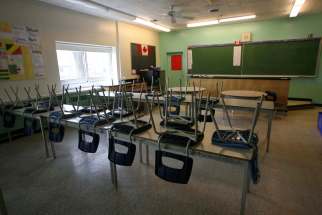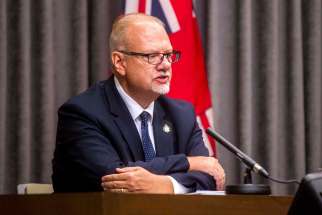Back-to-school plan must be flexible, adaptive
Read this article for free:
or
Already have an account? Log in here »
To continue reading, please subscribe:
Monthly Digital Subscription
$0 for the first 4 weeks*
- Enjoy unlimited reading on winnipegfreepress.com
- Read the E-Edition, our digital replica newspaper
- Access News Break, our award-winning app
- Play interactive puzzles
*No charge for 4 weeks then price increases to the regular rate of $19.00 plus GST every four weeks. Offer available to new and qualified returning subscribers only. Cancel any time.
Monthly Digital Subscription
$4.75/week*
- Enjoy unlimited reading on winnipegfreepress.com
- Read the E-Edition, our digital replica newspaper
- Access News Break, our award-winning app
- Play interactive puzzles
*Billed as $19 plus GST every four weeks. Cancel any time.
To continue reading, please subscribe:
Add Free Press access to your Brandon Sun subscription for only an additional
$1 for the first 4 weeks*
*Your next subscription payment will increase by $1.00 and you will be charged $16.99 plus GST for four weeks. After four weeks, your payment will increase to $23.99 plus GST every four weeks.
Read unlimited articles for free today:
or
Already have an account? Log in here »
Hey there, time traveller!
This article was published 20/08/2020 (1936 days ago), so information in it may no longer be current.
It’s probably safe to say that as summer vacation winds down, most kids dread heading back to school.
But this fall, there isn’t just getting back into classroom routine and homework to worry about. COVID-19 is on everyone’s mind — students, parents, teachers, administrators, support staff and elected officials. One question looms over all other logistical and political considerations:
Can students head back to class safely?
Politicians and educators have spent the summer considering how to approach the coming school year. The province last week unveiled its plan, which is built upon the foundational assertion that getting kids back into the classroom is essential for a wide range of practical, educational, psychological and economic reasons.
The challenges involved have been massive. Education Minister Kelvin Goertzen put it succinctly: “It’s been a summer like no other.”
For schools and teachers, who were forced to adapt on the fly to distance learning in March and then pivot to a partial reintroduction of students into the classroom in June, there has been no one-size-fits-all model for teaching and learning during a pandemic. And despite the government’s assertion that getting students back into classrooms is the main educational imperative for Sept. 8, the process and practices of the new school year will need to be similarly adaptive.
Not all will be in class every day. Those in kindergarten to grade 8 are expected to attend school five days a week. Schools may organize students into cohorts to limit intermingling, to mitigate the spread of COVID-19 and aid in contact tracing. Grades 9 to 12, in which most students take elective classes and thus cannot easily be organized into cohorts, will attend school on a more limited, rotating schedule, with remote-learning strategies in place for days students are not in class. Plans may vary according to school divisions’ individual needs.
Mask-wearing has now been mandated by the province, when physical distancing is not possible, for students in grades 4 and up — a change adopted after an education town hall at which parents voiced concerns about “recommended” mask usage.
Education officials and parent groups applauded the government’s willingness to adjust its position on masks, but concerns remain regarding class sizes, inadequate ventilation in older schools and the province’s insistence that remote-learning options will only be available to students with documented medical reasons for not being in class.
And then there’s the issue of funding. Despite the daunting logistics of getting students back to school — safely — while the pandemic continues to unfold globally and Manitoba’s COVID-19 case numbers maintain their recent unsettlingly elevated levels, the government has to date committed precious little in terms of additional financial resources to education for the coming school year.

The province’s most recent pandemic-related mantra is “We have to learn to live with this virus.” If that’s the case, it’s incumbent on government to provide the resources and support needed for an educational system that isn’t merely trying to hang on until the pandemic is over, but rather is forging a new path into a world in which a pandemic — if not the current one, then the one that arrives next — is part of schooling’s day-to-day reality for the foreseeable future.
The current framework is a good start. But the province needs to build on its back-to-school plan with specific support for ongoing measures — including funding for school upgrades, additional staffing and new technology — that will enable students to learn and will keep everyone, in school and at home, safe.













